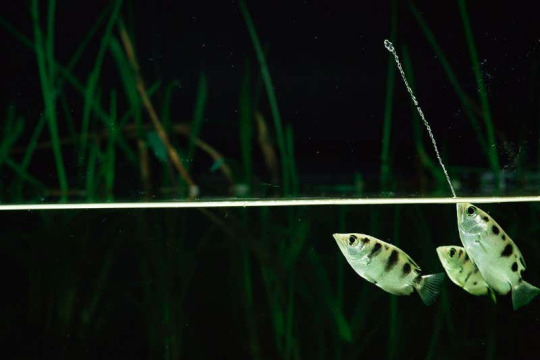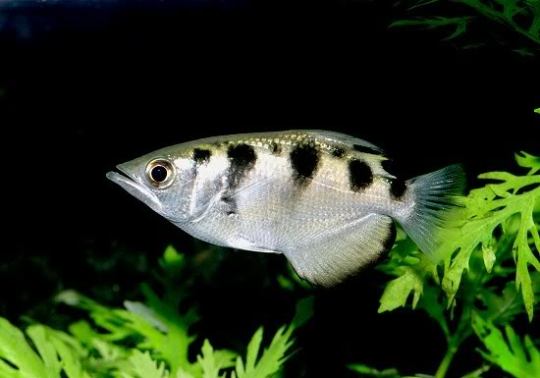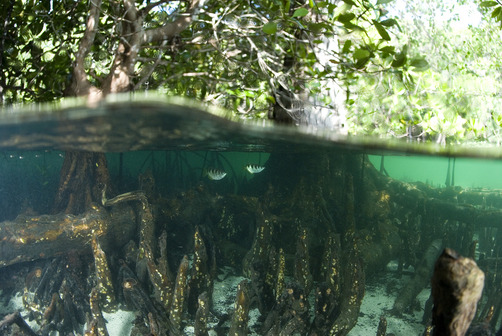#Toxotidae
Text
Taxonomy Tournament: Fish


Istiophoriformes. This order is made up of swordfish, marlins, sailfish, and barracudas
Toxotidae. This order is mad up of archerfish, also known as spinner fish, which predate insects by shooting water from their mouths to knock them into the water.
#animals#biology#polls#poll tournament#zoology#swordfish#barracudas#fish#archerfish#Istiophoriformes#Toxotidae#0x3v0xfc#Animal Tournament#Animal Tournament Round 1
141 notes
·
View notes
Text
Uncharismatic Fact of the Day
Archerfish, comprising the family Toxotidae, live up to their name-- they have special adaptations to their tongues and the roof of their mouths that allow them to shoot streams of water up to 1.5 m (5 ft) in the air! They use this ability to bring down airborne insects for them to feed on.

(Image: Banded archerfish (Toxotes jaculatrix) firing a watery missle by Kim Taylor)
If you like what I do, consider buying me a ko-fi!
#banded archerfish#Perciformes#Toxotidae#archerfish#Ray-Finned Fish#bony fish#fish#uncharismatic facts
80 notes
·
View notes
Note
🦴🦴🦴 (sea creatures ... maybe.....)
🦴 — there's a type of fish that's able to spit water at insects to make them fall into the water so the fish can eat them! they're known as toxotidae!
🦴 — although male betta fish are unable to live with one another , female bettas are perfectly capable of it! they often form sororities of over 4 members!
🦴 — swordtails & platies are two fish apart of the same family , they're similar enough that they can breed! most commonly , the swordtails's .. well , tail will be present in their offspring!
4 notes
·
View notes
Text

#archerfish #animalfacts #freshwaterfish
The archerfish is also known as Toxotidae, is a unique species of fish that belongs to the family Toxotidae. It is primarily found in brackish waters and estuaries of Southeast Asia and Australia. The name "archerfish" comes from its distinctive hunting behavior, where it shoots jets of water from its mouth to knock down insects and other prey from overhanging vegetation.
0 notes
Text
Organism of the Week - Banded Archerfish

The banded archerfish or scientifically, the Toxotes jaculatrix, is in the Animalia kingdom, Chordata phylum, Actinopterygii class, Perciformes order, and Toxotidae family.
The banded archerfish is described as a brackish water fish known for their ability to shoot a jet of water with their mouths. These fish are silver with five to seven semi-triangular dark bands on their sides. They have a lateral, compressed body and a flattened head with a pointed snout. Their big eyes have binocular vision, used to accurately hit their target of their water jet. Their dorsal fin is yellowish-green and is located towards their posterior end, shorter than their anal fin. Their anal fin is silver and their caudal fin is a dirty green, getting shorter from where it starts, In the wild, they grow up to 18.8 inches (29.97 centimeters) in length and in captivity, they grow up to 6 inches (15 centimeters). Their ability to spit a jet of water is used to capture prey. To do this, hey raise their tongue against the roof of their mouth and close their opercula, causing pressure on the water on the tube formed by their tongue to shoot. This jet of water can hit prey 2 to 3 meters away and can hit them within 50 milliseconds of hitting the water, The banded archerfish is omnivorous, with a diet consisting of plant matter, small fishes, crustaceans, and insects. They use their ability to shoot water to capture the insects above the water and they also use their ability to jump out of the water to capture them. They also may hunt together and all shoot together at a target, with every fish for themselves.

Banded archerfish are found in the waters of most of tropical Asia, Papua New Guinea, and northern Australia. Their habitat lies in coastal brackish (water with more salinity than fresh water, but not as much as seawater) and mangroves estuaries. They are found mostly in shallow, dirty water. They occasionally move into freshwater and saltwater from the brackish water.


The banded archerfish reproduces by broadcast spawning which means that the fish release their eggs and sperm into the water and fertilization occurs externally in eggs. They swim from the brackish water to saltwater coral reefs and rocks to reproduce. After the broadcast spawning occurs, the eggs hatch in about a few hours. The female lays approximately 20,000 to 150,000 floating eggs at a time that are about 0.4 millimeters (0.016 inches) in diameter. In captivity, it is difficult to breed the fish. They become mature at 1 or 2 years old and their lifespan in the wild is up to ten years old.
Fun Fact: The name ‘archerfish’ comes from the mythological archer, Sagittarius from the fish’s ability to shoot down their prey with water.
http://animal-world.com/encyclo/fresh/perches/ArcherFish.php#Breeding%20/%20Reproduction
http://www.aquariumofpacific.org/onlinelearningcenter/species/banded_archerfish
http://carnivoraforum.com/topic/9747017/1/
1 note
·
View note
Video
. ♥اكتب شيئ تؤجر عليه♥ . سمكة أرشرفيش النطاقات - Banded archerfish . . التصنيف العلمي المملكة : الحيوانية الأسرة في اللغات : الفقاريات الفئة : شعاعيات الزعانف الترتيب : فرخيات الأسرة : Toxotidae جنس : Toxotes الأنواع : T. jaculatrix الاسم العلمي : Toxotes jaculatrix . . تواجدها في المحيطين الهندي والهادئ و قبالة شمال استراليا إلى جزر الفلبين وجزر سليمان وأرخبيل الإندونيسي في المياة المالحة و مصبات الأنهار بين اشجار المنغروف المائية و هي الموئل الأساسي لها . . Its presence in the Indian and Pacific Oceans and off northern Australia to the Philippines Islands and the Solomon Islands in the Indonesian archipelago and salt water and estuaries between mangrove trees and water and is the main habitat her . . لا اله الا الله محمد رسول الله صلى الله عليه وسلم There is no god but Allah and Muhammad is the messenger of God . . سبحان الله - Subhan Allah . . بِسْمِ اللَّهِ الرَّحْمَنِ الرَّحِيم هذا خلق الله فأروني ماذا خلق الذين من دونه بل الظالمون في ضلال مبين - سورة لقمان - الآية 11 . . 👇👇👇 . #قران - #Quran . 👇👇👇 . @bosaif_aldhaheri @bosaif_aldhaheri @bosaif_aldhaheri .
0 notes
Text
Taxonomy Tournament: Fish


Toxotidae. This order is mad up of archerfish, also known as spinner fish, which predate insects by shooting water from their mouths to knock them into the water.
Syngnathiformes. This order is made up of fish with long narrow bodies, with some groups swimming with their bodies aligned vertically to blend in with seaweed. Examples include the seahorse, trumpet fish, and sea moths.
#animals#biology#polls#poll tournament#zoology#archerfish#fish#seahorses#trumpet fish#Toxotidae#Syngnathiformes#0x3v0x3c
90 notes
·
View notes
Text
Taxonomy Tournament: Fish


Toxotidae. This order is mad up of archerfish, also known as spinner fish, which predate insects by shooting water from their mouths to knock them into the water.
Carangiformes. This order contains the aggressively predatory dolphinfishes, and remoras, which have a sucker-like dorsal fin that allows them to attach to a larger host animal.
#animals#biology#polls#poll tournament#zoology#archerfish#fish#remoras#Toxotidae#Carangiformes#0x3v0x7c
59 notes
·
View notes
Text
Taxonomy Tournament: Results of Round 1
Long post, many stats.
The three biggest landslides were Opiliones (daddy longlegs) beating Parasitiformes (ticks) (87.89%, 334 to 46 votes), Terebellida (Pompeii worms) beating Scolecida (bamboo worms) (88.94%, 193 to 24 votes), and Hemiptera (true bugs) beating Phthiraptera (lice) (91.04%, 19 to 193 votes).
The three closest matches were Perissodactyla (horses and rhinos) beating Pholidota (pangolins) (50.6%, 747 to 765 votes), Caniformia (canines, bears, foxes...) beating Feliformia (felines, mongooses...) (50.28%, 538 to 532 votes), and Struthioniformes (ostriches) and Rheiformes (rheas) tying (50%, 144 to 144 votes).
To break the tie, I will discount my own vote (for Struthioniformes), so Rheiformes win.
Interesting that the top 3 landslides were all invertebrates (actually all top 7), while the 3 closest matches were all between Chordates (actually 4).
The average winning percent was 67.10% for all matches, and was 71.28% between non-chordates and 62.91% between chordates. So the chordate matches were closer in general.
As you may have guessed from the biggest landslides, parasites fared quite poorly. While the bracket started with 9 primarily parasitic clades, only 3 made it to this round (Hirudinea [leeches], Eucestoda [tapeworms], D. medinensis [nematode]) and all three were against other parasites.
The biggest landslide among Mammals was Didelphidae (possums) beating Hyracoidea (dassies) (80.26%)
The biggest landslide among Birds was Columbiformes (pigeons and doves) beating (flamingos) (72.34%)
The biggest landslide among Non-Avian Reptiles was Serpentes (snakes) beating Rhynchocephalia (tuatara) (60.60%). The closest match among Reptiles was Iguania (iguanas, chameleons...) beating Anguimorpha (Komodo dragon) (51.09%)
The biggest landslide among Cartilaginous Fish was Myliobatiformes (stingrays) beating Rajiformes (skates) (81.20%). The closest match was Rhinopristiformes (shovelnose ray, sawfish...) beating Torpediniformes (electric rays) (51.44%)
The biggest landslide among Bony Fish (and Chordates in general) was Osteoglossiformes (African Knifefish) beating Hiodontiformes (mooneyes) (84.71%). The closest match was Toxotidae (archerfish) beating Istiophoriformes (swordfish) (50.64%).
The biggest landslide among Echinoderms was Asteroids (starfish) beating Peripodida (sea daisies) (82.95%). The closest match was Echinacea (sea urchins) beating Gnathostomata (sand dollars) (55.38%).
The closest match among Annelids was Eunicida (eg. Bobbit worm) beating Phyllodocida (eg. Gossamer worm) (54.38%)
The biggest landslide among Gastropods was Neomphalida (volcano snails) beating Umbraculoidea (false limpets) (86.67%). The closest was Conidae (cone snails) beating Strombidae (conches) (51.39%)
The biggest landslide among Cephalopods was Sepiida (cuttlefish) beating Spirulida (Ram's horn squid) (77.53%). The closest match was Oegopsida (glass squid, giant squid...) beating Myopsida (European squid, reef squid...) (61.9%).
The biggest landslide among other molluscs was Polyplacophora (chitons) beating Scaphopoda (Tusk Shells) (84.35%). The closest was Heterodonta (edible clams) beating Palaeoheterodonta (freshwater mussels) (52.08%)
The closest match among Insects was Mantodea (mantises) beating Blattodea (roaches and termites) (72.9%). Interestingly still a pretty big landslide.
The biggest landslide among Crustaceans was Thecostraca (barnacles) beating Tantulocarida (parasites of crustaceans) (83.33%). The closest match was Branchiopoda (fairy shrimp) beating Copepods (56.54%)
The closest match among Invertibrates was Eucestoda (tapeworms) beating Amphilinidea (parasites of turtles) (50.65%).
Round 2 starts tomorrow!
#Animal Tournament#Animal Tournament Announcements#biology#taxonomy#animal biology#marine biology#evolution#zoology#tumblr polls#tournament poll#poll tournament#bracket tournament
41 notes
·
View notes